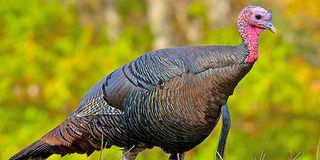Experts' take on issues troubling farmers

A turkey. This fairly unique poultry is mainly kept for eggs and meat as well as its aesthetic value.
What you need to know:
- Naturally, turkeys are good brooders and can hatch about 15 eggs.
- Brooding takes about 4-6 weeks from day-old, depending on the breed.
- Turkeys are susceptible to diseases and as such, deworming, vaccination and biosecurity measures are mandatory to prevent or slow down the spread of infections or disease-causing organisms.
- There is demand for turkey meat in the market in both dressed weight and whole bird, where toms of 10-20kg are sold at an average of Sh1,500 per kilo.
Rearing turkeys: Dos and don’ts of keeping turkeys
I would like to know more about keeping turkeys.
Khodar
Turkey is a fairly unique poultry. The birds are mainly kept for eggs and meat as well as aesthetic value.
Breeds vary, with many preferring to keep the Broad-chested white or Royal palm. As a new entrant in the business, you can begin by getting day-old poults (though not common among commercial breeders), buying hens and a tom/gobbler (male turkey) and grow your flock.
Buying eggs and incubating has also worked for some farmers, though getting quality fertilised eggs for incubation is a challenge.
Incubation period is 28 days. Naturally, turkeys are good brooders and can hatch about 15 eggs. Brooding takes about 4-6 weeks from day-old, depending on the breed.
During this time, provide supplemental heat using infra-red bulbs or the largely available charcoal (briquette) jikos.
Set up the brooder days before the poults are brought in, ensure the area is well-cleaned and disinfected. Spread the floor with saw dust/wood shavings for warmth and avail disinfected feeders and drinkers.
On production system, rearing can be done under free-range or housing the birds full time under intensive care.
For the former, provide a shade or cool environment secured from predators during the day and warm housing at night.
Being a bigger size of poultry, turkeys need a bigger house spacing of about two birds per square metre. On feeding, start your turkeys on starter mash and switch to growers’ mash on the tenth week and mix with some grit.
Provide clean water throughout. It is advisable to provide them with supplements and greens for those kept under intensive system for healthy growth.
Turkeys are susceptible to diseases and as such, deworming, vaccination and biosecurity measures are mandatory to prevent or slow down the spread of infections or disease-causing organisms.
Other management practices include toe clipping, desnooding, debeaking to control feather pecking and cannibalism and other health management practices.
There is demand for turkey meat in the market in both dressed weight and whole bird, where toms of 10-20kg are sold at an average of Sh1,500 per kilo. Festive seasons fetch higher prices.
Maureen N. Ogega, Department of Animal Science, Egerton University.
****
Cocopeat treatment
How do you know that cocopeat has been treated before you buy?
Dennis Mutugi
Untreated cocopeat is usually in blocks. However, once the cocopeat is soaked in water, it hydrates and expands.
It’s difficult to tell if the cocopeat is treated or not by having a cursory look. However, one can test for its electrical conductivity.
Ann Macharia, agronomist.
****
High-yielding crops to grow
Which is the most high-yielding crop that I can plant on 0.5 acres in a high altitude area in Kinungi? The area is mostly cold.
Kamau Gitahi
Kinungi all the way to Naivasha is best-suited for flower farming. Such ventures need large pieces of land, thus, you can try potato farming, which with good management can offer you high yields.
Sillus Oduor,
Department of Crops, Horticulture and Soils, Egerton University.
****
Market for rabbits
I am a rabbit farmer in Kitui County. Is there a ready market for the animals?
Brian
Rabbits are commercially kept for meat, but a few people sell their fur, manure and urine. There is growing consumption of rabbit meat as incomes rise and the know-how on the benefits of consuming white meat grows.
Restaurants, supermarkets and butcheries are among the main markets for rabbits. With the discussion around re-introducing agriculture as a subject in primary schools going on, it is fair to argue that the future of rabbit industry is promising as this could fairly improve awareness of its benefits as well as market when parent stocks are bought for learners.
Apart from marketing rabbit products through the few available channels, you can also use online platforms.
Maureen N. Ogega, Department of Animal Science, Egerton University.
****
Garlic seeds
I would like to grow garlic and I need seeds or seedlings. Please assist.
Franco
Garlic is propagated vegetatively. Cloves are separated and mainly used as the propagation material because garlic does not produce seeds.
Cloves are sown in drills of 30-40cm apart and 10-15cm within the rows. Garlic seedlings are available from Garlic and Pepino Farm, Nakuru, kindly reach them on 0723 713642.
They also offer training on garlic farming. You can also produce your own seedlings by first pre-germinating the cloves so that they have roots and a shoot.
Carol Mutua.
Department of Crops, Horticulture and Soils, Egerton University.
****
Fertiliser for planting onions
What artificial fertiliser should I use for planting and top dressing onions?
David Bor, Kericho
Fertiliser application is best determined by testing your soil. This prevents the application of nutrients that are already in the soil.
However, onions require high levels of phosphorus for root development, nitrogen at the vegetative stage, and potassium while bulbing.
Ann Macharia, agronomist.





